| The Radio Electric Company opened for business on
10th July 1922, as can be seen from the advert. The premises were on
the eastern side of Worcester Street, in between Temple Street and
Church Street. The advert includes a reference to Mr. H. H. Speke,
the chairman of Wolverhampton's first amateur radio society, the Wolverhampton and District Wireless Society. The
society's first
meeting took place on 1st March, 1922.
Mr Speke had a shop at 26
King Street, in which he sold models, toys and books, and later
ex-army and navy surplus items. |
 |
| The company's first shop at 33 and 34
Worcester Street. As seen in 1961
when it was occupied by a tobacconist.
Photo courtesy of John Hughes. |
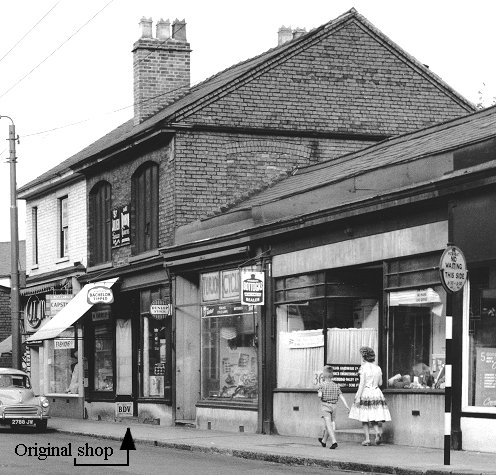 |
| The Radio Electric Company was started by George Jones, the
Secretary of the Wireless Society who had the call sign 2WB. He
had previously worked for Mr. Speke in King Street. When he
started the business he relinquished his secretarial duties due
to pressure of work. Within six months the business had moved to
a shop in St. John's Street. |

A map showing the location of the Radio Electric
Company's shop in St. John's Street. |
Mr. Jack Rushton was an amateur radio enthusiast with the
call sign 5LK. Jack had a shop at 17 Victoria Street called 'Radio,
Motors and Cycles Limited' (marked in orange on the map), where
Halfords used to be. There was a link between Jack Rushton's
business and the Radio Electric Company, because Jack's
name was included on the Radio Electric Company's letterheads.
The two shops were also linked by a connecting yard at the
back. A redirected envelope dated April 6th, 1923, found in
the personal records of the late George Jones suggests that he
may have left the business by that time.
|
| At St. John's Street, Mr. Creed worked in the shop and
George Berry, the son of amateur radio enthusiast, H. Berry, who
had the call sign 6PB, was employed to build wireless sets. The
cellars below the shop were used to charge accumulators, which
in those days were an essential part of any valve receiver.
The
St. John's Street shop was situated on the corner, where the
street turned sharply to lead alongside the old Mander's
works. Also on the staff were Mrs Creed and Mr. C. Fenwick. Mr.
Creed later became manager of the 'Radio, Motors and Cycles'
shop in Victoria Street, where receivers were constructed by
Arthur Shaw, who was Mrs Creed's brother. He built quantities of
a popular domestic crystal set which sold for seven shillings
and sixpence. |
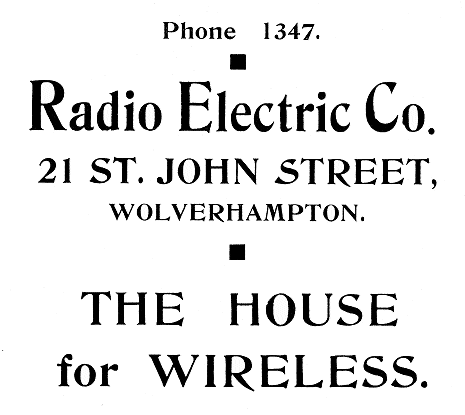
An advert from 1924. |
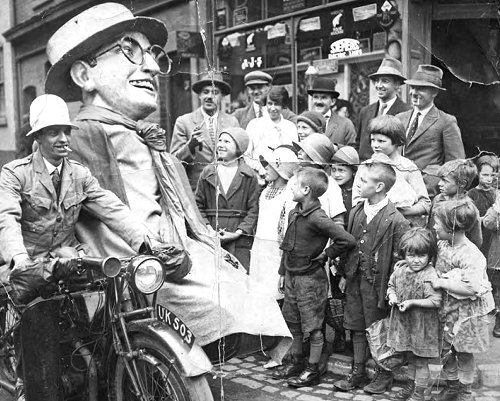 |
A photograph taken outside the St.
John's Street shop with Jack Rushton and the staff in the
background. |
|
When the Wolverhampton and
District Wireless Society ceased to exist, it was replaced by
the Wolverhampton & District Transmitters' Society, members of
which used to meet in the Radio, Motors and Cycles' shop and
also in the Radio Electric Company's shop in St. John's Street. During 1925 'Radio, Motors and Cycles Limited' had either
joined forces with the Radio Electric Company or been taken over
by it, as can be seen from the advert above.
By the middle of the year, the Victoria Street Shop traded as
part of the Radio Electric Company, which also had premises at
Church Street, Bilston. Presumably another shop.
|

A crystal set made by the Radio
Electric Company in possibly 1923 or early 1924. |
| In the 1925 Wolverhampton Red Book, the Victoria Street
premises is listed under the name of the Radio Electric Company,
but both the 1927 and 1930 Red Books list it as Radio, Motors
and Cycles Limited, so both names continued to be used. In 1930
the business closed, and the Victoria Street shop was taken over
by Halfords. When this happened Arthur Shaw started his own
radio business in Queen Street, and Mr. C. Fenwick opened his
radio and components shop at the eastern end of Great Brickkiln
Street (now Pitt Street), which many people will fondly
remember. Next door he had another shop selling fishing tackle,
toys, models, and guns. |
|
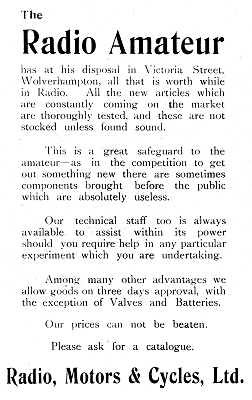
An advert from 1925. |
|
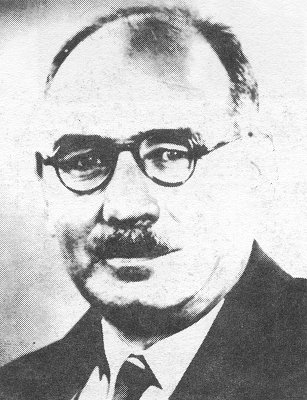
Jack Rushton. |

A Radio Motors and Cycles receiver
from 1925. |
|
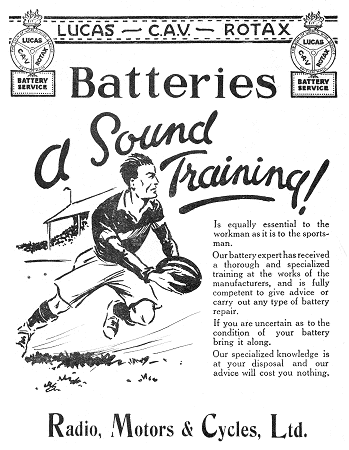
An advert from 1925. |
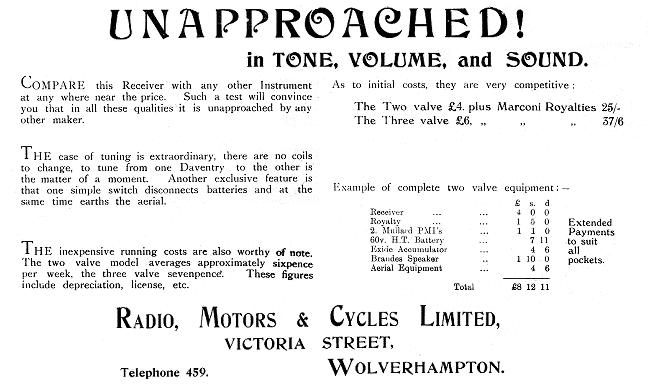
An advert from 1925.
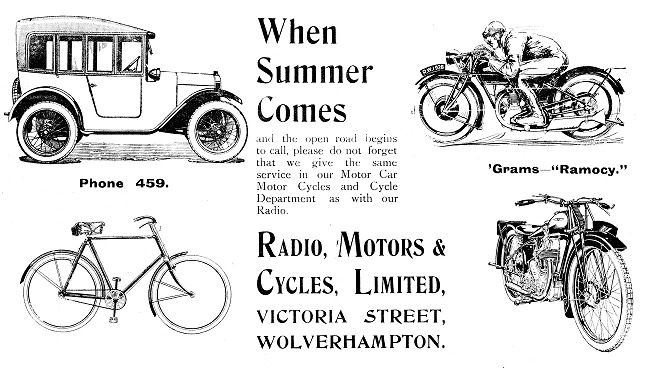
An advert from 1925.
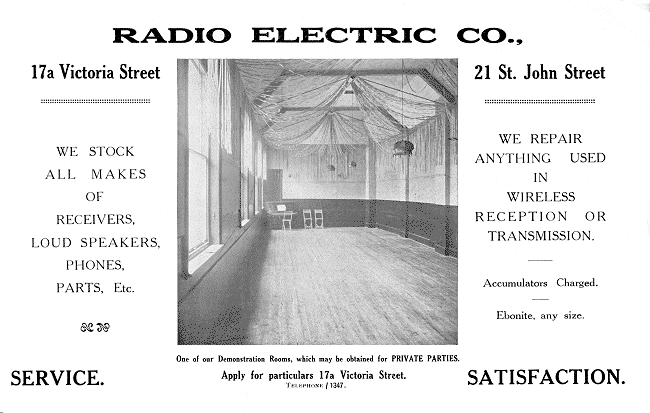
An advert from 1925 which
shows the 2nd floor room above the Victoria Street shop where
meetings of the Wolverhampton and District Transmitters Society
were held. |
|
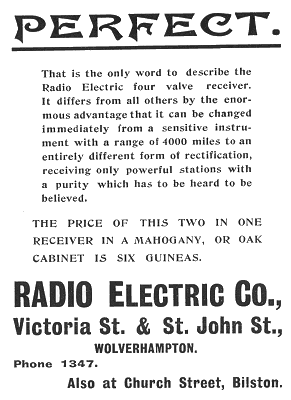
An advert from 1926.
|
The advert on the left confirms that the Radio Electric Company produced valve receivers, rather than just crystal sets,
which may have been identical to the receiver described in the
Radio Motors and Cycles advert above. Maud Highfield worked in
the Victoria Street shop and remembered Jack Rushton as an
enterprising man and a very good business man.
She remembered a workshop at the back of the Victoria Street
premises, and an open space, which came out into John's Street
where Jack Rushton sold caravans. He also had a room above the
Central Arcade at the lower end, where he employed two girls to
make radio sets. In the cellar of the shop was a strong room and
a place where coal was kept, and the area where batteries were
charged. Two ladies came in to light the coal fires in the shop
every day.
Burroughs adding machines and Gledhill tills were used in the
shop which had beautiful display cases. Items for sale included
Parlophone and Eddison Bell records, Cosmos, Philips, Ecko and
K.B. radios, radio components, Ariel and Douglas motorcycles,
and Rudge bicycles.
|
| In the photograph opposite, the top two terminals are aerial and earth
respectively and the bottom terminals are for headphones. The
two switches are for tuning. The one on the left is coarse
tuning and the one on the right, fine tuning.
The plug and socket on the far left is for the plug-in Medium
or Long Wave coil.
A Long Wave coil would have certainly been desirable after
the opening of the BBC's Daventry transmitter in 1925. |

Another view of the Radio Electric
Company's crystal set. |

Circuit diagram of the crystal set made by the
Radio Electric Company.
| The receiver is extremely simple. The tuned circuit consists
of a plug-in coil in series with a much smaller tapped and
switched inductance, which is used for tuning, along with the
self capacitance of the coils. Coarse and fine tuning is
possible by the positioning of the taps on the coil. The fine
tuning switch increases or decreases the inductance in smaller
steps than the coarse tuning switch.
The aerial is connected directly across the tuned circuit.
Although this will effect the tuning and the selectivity of the
receiver, it is of no great significance because the tuned
circuit will already be heavily damped by the cat's whisker and
headphones. Like the aerial, the cat's whisker and headphones in
series are connected directly across the tuned circuit, which
was normal practice in such a simple design.
This is clearly a simple and cheap receiver, aimed at the
bottom end of the market. It's performance is poor, but it would
have been affordable to almost anyone and so would have helped
to bring radio to the masses, at a time when valve receivers
were still very expensive. This may well be one of the crystal
sets that were sold for just 7s.6d. |
| The inside of the receiver showing
the crude form of construction. The coil is home-made and wound on a
large cardboard tube. |
 |
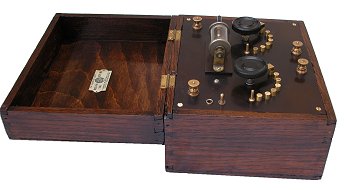 |
An overall view of the receiver
showing the oak case. |
| The licence plate that's mounted
inside the cabinet lid. The low registration number suggests that it was
made soon after the formation of the BBC in 1923. |
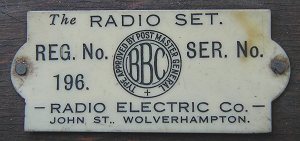 |
 |
A close-up view of the cats
whisker. The handle on the right allows the cat's whisker to be adjusted
to make contact with a suitable spot on the crystal. |
| Another view of the
receiver, complete with plug-in Medium Wave coil. |
|
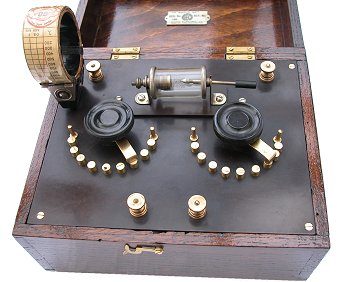 |
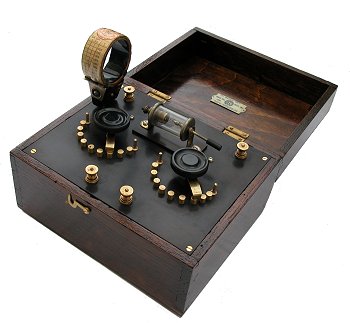 |
A final view of the receiver, complete
with plug-in coil. Although this is a bottom of the range
receiver, it is still nicely finished. |
| Pieces of crystalline material for use
in the receiver. The crystal is often a small piece of galena
(lead sulphide), although other materials were used.
In the receiver the cat's whisker is
enclosed in a glass tube to exclude dust. The crystals are quite
soft and will soon wear as the point of cat's whisker is dragged
across the surface, so replacements were essential. |
 |
| J. V. Rushton Jack Rushton
was a man of many talents. He lived at 134 Mount Road, Penn, and
became an accomplished pilot of light aircraft and trained glider
pilots. He also experimented with magnetic wire recording, to record
pictures and send them by radio and wire. He made improvements to
storage batteries, including a failed attempt to produce a
lead-aluminium battery, during which he developed his own method of
anodising aluminium.
After the closure of the Radio Electric Company, Jack began
producing 'Rushlite' dry batteries at Rushlite Batteries Limited
in Temple Street, Wolverhampton, and sold many during World War 2
when batteries were in short supply. Battery production continued
until about 1955. From 1956 onwards the business ceased to be listed
in the Wolverhampton Red Book. |

A 'Rushlite' battery.

Another view of the 'Rushlite' battery.
| Jack continued to be actively involved in amateur radio. He
became a honorary member of the Wolverhampton and District
Transmitters' Society, and was society president from 1924 until
1934. 1946 saw the formation of the Wolverhampton Amateur Radio Society.
Jack became society president in 1947, and remained in post until 1964.
By the 1930s Jack had become a proficient pilot, who greatly enjoyed
gliding. He was involved in the formation of the Midland Gliding
Club on the Long Mynd in Shropshire, and in 1930 was club
secretary. On 24th July, 1937 he won the Volk Cup for the longest
duration flight during the previous twelve months. He received the
cup for a flight of eight hours in a glider at the Midland Gliding
Club. In the same year he competed in the National Soaring Meeting,
flying a Grunau Baby II. In the Second World War he put his flying
experience to good use, training glider pilots. |
|
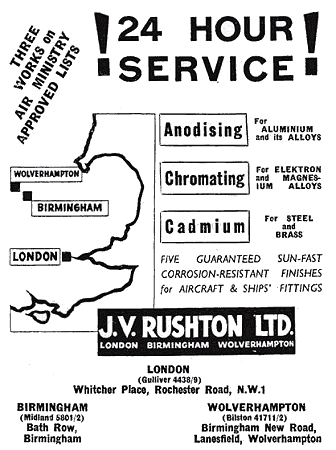
An advert from 1939. |
Jack Rushton had a number of business interests. He ran J.V.
Rushton Limited based at Anodic Works on the Birmingham New Road in
Wolverhampton. The firm specialised in electroplating, anodising,
chrome plating, general metal finishing, and hardening, particularly
for the aircraft industry.
The company was founded in 1936 and soon expanded and opened
other factories:
1937 - J. V. Rushton (Birmingham) incorporated
1937 - J. V. Rushton (London) incorporated
1941 - J. V. Rushton (Coventry) incorporated
1941 - J. V. Rushton (Redditch) incorporated
Jack also owned the Coventry Chromium Plating
Company.
|
|
The edition of Flight magazine published in
April 1937 includes the following brief article:
J. V. RUSHTON (LONDON), LTD., was registered as
a private company on March 10 with a nominal capital of £5,000 in £1
shares.
Objects : to construct and work plants for anodising, more particularly to
Air Ministry specification, in association with J. V. Rushton (Wolverhampton).
Ltd., and J. V. Rushton (Birmingham), Ltd. (when incorporated), and
generally for the protection and colouring of aluminium and its alloys; to carry
on business as anodisers, metal finishers, depositors and sprayers, etc.
The
subscribers are John V. Rushton, 134, Mount Rd., Penn, Wolverhampton, anodic
oxidation chemist; and Mrs. Florence Rushton. |
|
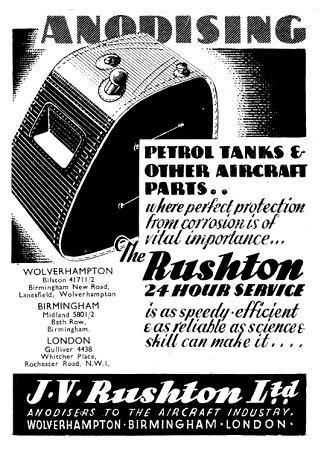 |
|
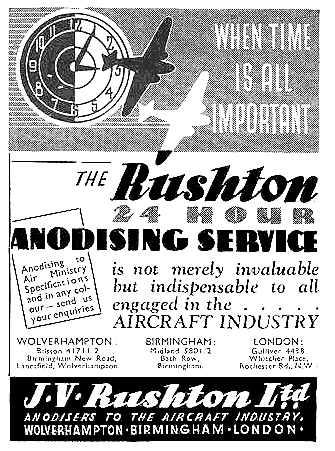 |
| |
|
From 'The Aeroplane', February 7th, 1941. |
|
| By 1946 the companies had been taken over by Midland Holdings, a
holding company for what was possibly the largest group of electroplaters, anodisers, and
metal finishing businesses in the country. It had plants in
Birmingham, Wolverhampton, Coventry, Manchester, Newbury, Cardiff,
and Scotland. Jack Rushton was also a Rotarian. The following
article written by him appeared in the April 1951 edition of The Rotarian: |
|
What Freedom Would We Lose?
J. V. Rushton, Rotarian
Past Service
Wolverhampton, England
At one time people feared only the weapons in
the hands of their opponents. Now progress has made modern weapons a
danger to all. This year the world is spending
considerably more than 10,000 million pounds on preparing for war;
only a fraction of this amount would be necessary to support a world
force to maintain world peace. What freedom would we lose if we
surrendered our armed strength to such a world force? Individually
we would probably find ourselves with much more freedom, freedom to
travel and trade in any part of the world - a world without
frontiers; and even more important we would be free from the fear of
war.
I think that if America and England were to
declare that they were willing to surrender their forces to a world
government, other countries would rapidly follow suit, because I
believe that the people of every country of the world are scared of
war and that they know that behind all their bluff there is no other
way of avoiding it.
|
|
| Jack Rushton left the West Midlands and retired to the
Channel Islands. |
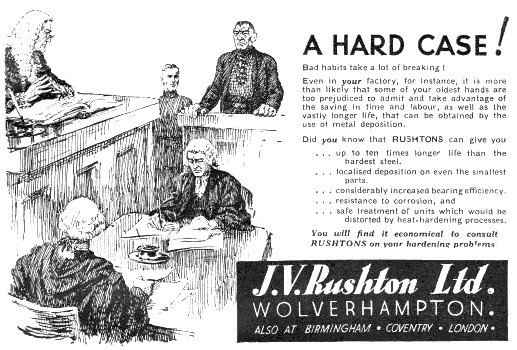
An advert from 1944.
| The information on the Radio Electric Company company was obtained from 'Wireless
In Wolverhampton', published by the Wolverhampton Amateur Radio
Society in 1972. If you have any further information about the
company, or its products, please
send me an email. |
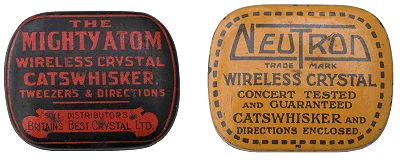

|
Return to
the list of manufacturers |
|